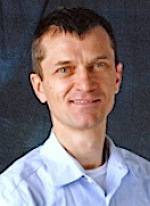Open-source tools will benefit military and Wisconsin vehicle makers
For the U.S. Army, it’s important to know how military vehicles will perform on different terrains in different scenarios.
That knowledge is traditionally acquired by running field tests or by using limited simulation models developed shortly after World War II. However, this approach is expensive, inexact and time-consuming.
Dan Negrut, a University of Wisconsin–Madison associate professor of mechanical engineering, has received a $1.8 million grant from the Army to harness the power of supercomputers to set up a simulation software infrastructure and allow both military and civilian vehicle makers to better understand — and predict — how vehicles will respond to deformable terrain, such as sand, mud or riverbeds.

Dan Negrut
“In an ideal world, you’d be able to gauge the performance of the vehicle without having to build it,” says Negrut. “This will allow for better designs, reduced costs and reduced design cycles because rather than waiting months to test things in the field, we can do it on a computer.”
Negrut says the project has attracted interest beyond the military. In response, the team has launched the Machine-Ground Interaction Consortium, which will bring state and national vehicle makers together with researchers from around the world. Current industry participants include Caterpillar, John Deere and BAE Systems, along with Wisconsin-based Oshkosh Corporation, Trek Bicycle, Harley-Davidson and P&H Mining.
All of the software Negrut’s team develops will eventually be made publicly available through a website. “We believe making it all open source is the best way to ensure this transfer of technology from us to industry, where people can take advantage of the techniques and the software that we develop as part of this project, so as to foster innovation here or elsewhere in industry,” Negrut says.
“This will allow for better designs, reduced costs and reduced design cycles because rather than waiting months to test things in the field, we can do it on a computer.”
Dan Negrut
In addition to creating software, Negrut’s collaborators will also validate their methods through experiments. For example, William Likos, a UW–Madison associate professor of civil and environmental engineering and geological engineering, will examine how wheels move in sand so the team can assess how closely the simulations match real-world measurements.
Negrut says the eventual goal is to allow vehicle makers to simulate scenarios that are currently impossible, such as predicting how fast a vehicle can move through water. “That cannot be done today through modeling simulation,” Negrut says. “It’s not yet clear to what extent we can understand certain things through computer simulation, and we’re trying to advance the spectrum of problems for which modeling simulation is good enough.”
—Adam Malecek
Subscribe to Wisconsin Ideas
Want more stories of the Wisconsin Idea in action? Sign-up for our monthly e-newsletter highlighting how Badgers are taking their education and research beyond the boundaries of the classroom to improve lives.




